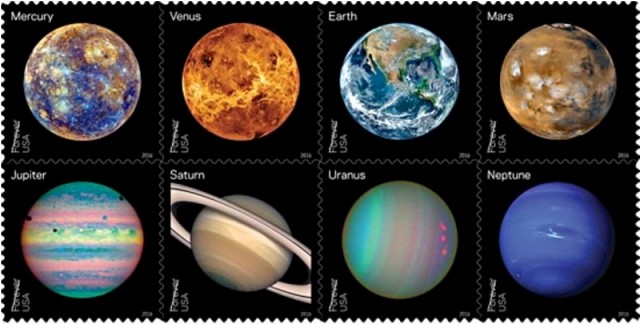It is an amazing set of 40 stamps issued May 27, 2006, representing all kinds of American wonders (natural and man-made). I'll try to be brief on each stamp...otherwise I'm pretty sure you'll click the 'x' button somewhere in the middle of your reading :) Or you can just skim the post and maybe hold on to something that catches your interest.
So starting from top row, from left to right we have:
- The American alligator, America's largest reptile: 11 feet long and weighing 450 to 600 pounds. The largest one on record however measured 19 feet in length.
- The highest sea cliffs, Molokaʻi: The sea cliffs along the northeastern coast of Moloka`i, one of eight major islands in the state of Hawaii, are the highest in the world
- The tallest cactus: The saguaro cactus, symbol of the American Southwest, can grow taller than a five-story building. One record-breaking specimen in Arizona reached a height of nearly 60 feet
- The largest glacier: Bering Glacier, near Cordova, Alaska, is the nation’s largest glacier. It is about 126 miles long and about 30 miles wide near its terminus.
- The tallest dunes: The Great Sand Dunes rise more than 750 feet above the floor of the San Luis Valley, at the base of the Sangre de Cristo Mountains in Colorado
- The largest estuary: the Chesapeake Bay cuts across Maryland and Virginia; it is almost 200 miles long and from 3 to roughly 30 miles wide
- The largest cliff dwelling: The multistory pueblo known today as Cliff Palace, in Colorado, was a large complex containing many rooms. This mysterious archaeological wonder, built centuries ago in the shelter of a canyon wall, was constructed primarily of sandstone, mortar, and wooden beams.
- The deepest lake: At its deepest, the bottom of Crater Lake, in Oregon, is 1,943 feet below the water’s surface.
- The largest land mammal: the American bison typically reach 7 to 11 feet in length and weigh 900 to 2,200 pounds.
- The longest reef: The Florida Keys, a chain of islands approximately 220 miles long, curve south and west of mainland Florida. Stretching along beside them, about six miles seaward, is a long barrier reef (I have some lovely postcards featuring these!)
moving onto the second row:
- The longest hiking trail: The Pacific Crest Trail is the nation’s longest continuous designated hiking trail, running for 2,650 miles from Mexico to Canada, through California, Oregon, and Washington (this is something I would love to give it a hike!)
- The tallest man-made monument: The Gateway Arch, in St. Louis, memorializes the national expansion that took place under President Thomas Jefferson. Completed in 1965, the arch spans 630 feet and rises to the same height.
- The oldest mountains: The Appalachian Mountains stretch along the East Coast in a southwesterly direction from Canada to Alabama. Many geologists estimate that the birth of this mountain chain took place nearly half a billion years ago, when tectonic plates collided
- The largest flower: the American lotus flower may reach 10 inches in diameter; its single round leaf can reach more than 2 feet in diameter
- The largest lake: The largest of the five Great Lakes, Superior shares waters with Canada and covers a surface area of about 31,700 square miles. Lake Superior is approximately 350 miles long; its maximum depth is 1,333 feet
- The fastest land animal: The pronghorn (?!) can reach speeds around 60 miles per hour and can maintain a pace of 45 miles per hour for several minutes. The only faster land animal is the cheetah, reaching speeds of 70 miles per hour for short distances
- The oldest trees: The oldest bristlecone pines, so named for the long, hooked spines on the scales of their cones, are more than 4,500 years old.
- The tallest waterfall: the Yosemite Falls, in the Yosemite National Park in California, is actually in three sections with a total drop of 2,425 feet. An upper waterfall (1,430 feet) and a lower one (320 feet) are separated by small plunges and rapids (675 feet)
- The largest desert: The Great Basin covers an area of roughly 190,000 square miles, mostly in Nevada.
- The longest span: The Verrazano-Narrows Bridge, connecting Brooklyn and Staten Island, is named after Giovanni da Verrazano, a European explorer who sailed into the area in 1524. Two towers, each 693 feet tall, stand 4,260 feet apart; the bridge’s total length is 13,700 feet.
third row:
- The windiest place: The summit of Mount Washington, in New Hampshire, holds the official record for the maximum wind gust ever recorded on land-and not associated with a tornado or hurricane. On April 12, 1934, an anemometer recorded a wind gust of 231 mph (that is a cool feature to hold a record of :))
- The largest canyon: The Grand Canyon is 277 miles long. At its widest point, it is more than 15 miles across; at its deepest, it reaches down more than a mile
- The largest frog (yuck!): the American bullfrogs can reach more than six inches in length; males weigh up to one pound and their calls can be heard from a quarter mile away
- The tallest dam: The Oroville Dam, on the Feather River in northern California, stands 770 feet tall and is 6,920 feet long at its crest
- The fastest bird: When diving after prey, the peregrine falcon is the world’s fastest bird, reaching speeds of 200 miles an hour or more
- The largest delta: The Mississippi River delta, where the mouth of the river meets the Gulf of Mexico, covers approximately 11,000 square miles, roughly a quarter of the state of Louisiana
- The tallest geyser: Steamboat, a popular attraction in Yellowstone National Park, is the world’s tallest active geyser. At unscheduled intervals, it sends rockets of water soaring as high as 300 feet or more, though minor eruptions of 10 to 40 feet are more common
- The largest natural bridge: The world’s largest natural bridge, Rainbow Bridge, is in southern Utah; it is 275 feet across and 290 feet tall.
- The largest freshwater fish: The white sturgeon is the largest freshwater fish in North America. One record-setting specimen, from the Snake River in Idaho in the 19th century, reportedly weighed 1,500 pounds. The white sturgeon typically reaches about 12 feet in length.
- The longest mountain chain: The Rocky Mountains stretch more than 2,000 miles through several western states.
still alive? coz we are finally at row 4 :)
- The tallest trees: the Coast redwoods, the tallest trees in the world today, range from central California to southern Oregon. Most of these giants stand between 200 and 300 feet tall, though they can reach more than 350 feet
- The largest rodent: The average adult beaver weighs between 35 and 40 pounds; the largest can weigh more than 60 pounds and be three feet tall when standing on its hind legs.
- The longest river system: From the headwaters of the Missouri River, in the Rocky Mountains, to the great delta where the Mississippi River empties into the Gulf of Mexico, the Mississippi-Missouri river system stretches more than 3,700 miles
- The rainiest spot: Mount Wai`ale`ale, on the island of Kaua`i in Hawaii, has an average annual rainfall of about 400 inches. (the name is somewhat hilarious I must note :P)
- The most active volcano: Kilauea in Hawaii, has had 55 eruptive episodes since 1983; it typically produces more than 10 million cubic feet of lava every day
- The longest cave: More than 365 miles of passages have been explored and mapped in Mammoth Cave, in Kentucky. This is the longest known cave in the world.
- The loudest animal: Blue whales, found in all the world’s oceans, including U.S. waters, are the biggest and loudest animals on Earth. They can emit sounds at a volume greater than 180 decibels in water, but pitched too low for humans to detect without sensitive equipment.
- The hottest spot: In Death Valley, one of the hottest places on Earth, summer temperatures average more than 100 degrees Fahrenheit. A record high of 134 degrees was measured there in July 1913. The valley floor is even hotter than the surrounding air (I guess there are worse places than here where I live).
- The longest covered bridge: This landmark bridge accommodating two-way vehicular traffic between the towns of Cornish, New Hampshire, and Windsor, Vermont, is about 450 feet long.
- The largest plant: The root system of a quaking aspen tree can produce a clone that appears to be an entire grove. A clone in Utah named Pando (Latin for “I spread”) weighs an estimated 6,600 tons, making it one of the most massive living organisms known.
thanks a lot to the Bryon fairy for taking his time to attach each of these 40 beauties..it certainly aint an easy task :)
to see how others have been inspired today, visit the Viridian's blog :)


